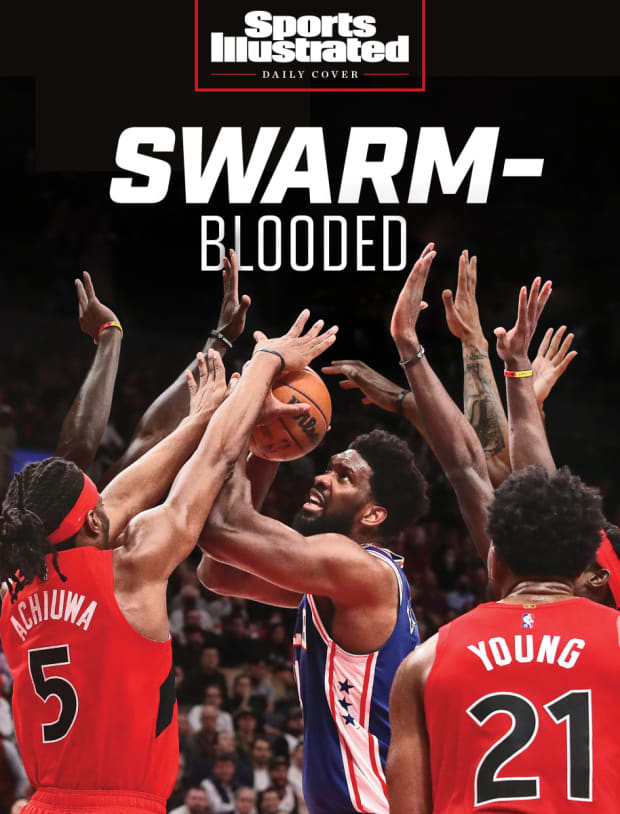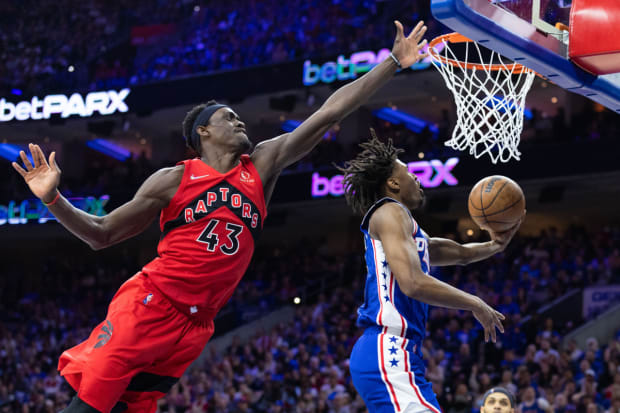It’s often said that the first contest in a best-of-seven series is a feel-out game, and in the case of the Raptors—who got blasted by Philadelphia this past weekend in Game 1—they’ll likely need that to be the case.
In the series opener, Toronto had a Murphy’s Law sort of performance on defense: Just about anything that could go wrong did go wrong.
- The Raptors’ intricate web on D, like the countless inner parts of a pricey wristwatch, accomplished its main objective, holding scoring champ Joel Embiid and future Hall of Famer James Harden to just 11-of-32 from the field combined.
- But in throwing so much attention at that duo to suppress its scoring, the Sixers’ other players had a field day, with guard Tyrese Maxey logging a playoff-career-high 38 points and Tobias Harris having 26 points on just 14 shots.
- Philadelphia, which hit 16 of its 32 triples on the afternoon, finished with 29 assists and didn’t commit a single turnover until the third period.
- Adding to Toronto’s misery: Versatile Rookie of the Year candidate Scottie Barnes (sprained ankle), veteran forward Thaddeus Young (sprained thumb) and sharpshooting guard Gary Trent Jr. (non-COVID-19 illness) are doubtful for Game 2.

Photo Illustration by SI Art; Steve Russell/Toronto Star/Getty Images (2)
But between the lopsided nature of their 131–111 Game 1 loss and the strong possibility that the Raptors will be shorthanded heading into Game 2, it could be enough to obscure the fact that Toronto is perhaps the most strange, experimental club in the league. And in a way, without their depth, the Raptors may have to lean into their beautiful, patented weirdness on defense even more to fend off playoff extinction.
There’s a bit of irony at play with this basketball franchise, which drew its name from a fan vote in 1994, less than a year after the release of the enormously popular film Jurassic Park. Raptor dinosaurs, which roamed the earth approximately 75 million years ago, were thought to have had disproportionately short arms. By contrast, the Toronto Raptors in 2022 are the exact opposite, standing out because of their never-ending arms.
Take their January showing against Bradley Beal and the Wizards, for example. The swarming Toronto defense hounded the three-time All-Star into a career-high nine turnovers that night.
“It’s not like I was just throwing that b---- all over the floor,” Beal said in explaining the miscues the Raptors forced. “They were swiping down while I was in traffic. There were a lot of guys with their hands in there. They were shrinking the floor. They got steals. They were able to get their hands on a lot of them.”
Almost nothing with this Toronto team is typical. The Raptors’ arm lengths make routine passes nearly impossible for opponents. They deflect more passes than any NBA team and force turnovers at the highest rate in the league. It’s a huge part of the reason that opponents take longer to find shot attempts against Toronto than almost anyone else, according to data site Inpredictable. On some level, this long-limbed team makes shooters and passers think more than they’d like to from one play to the next.
Of the 14 players who’ve logged at least 200 minutes for the Raptors this season, just two—point guards Fred VanVleet and backup guard Malachi Flynn—are shorter than 6'5". Most are at least 6'7" and have wingspans that generally surpass the 7-foot mark.
Yes, teams have invested in lineups that tout ridiculous athleticism and length before. During its controversial “Process” era, led by Sam Hinkie, the Sixers made a point to prioritize wingspan, utilizing 6'5" Michael Carter-Williams at point guard before eventually landing 6'11" point forward Ben Simmons. The Bucks also considered acquiring length an organizational priority for a few years closer to the beginning of Giannis Antetokounmpo’s time in the league before winning it all in 2021. In between those phases, the Warriors had its utterly dominant Death Lineup—and, later, The Hamptons Five group—smothering offenses with four switchy defenders that each stood at least 6'6" with massive wingspans.
Still, it’s hard to imagine that any club has ever been this committed to having length advantages virtually all the time. Even if someone like All-Defensive Team candidate Fred VanVleet gets beat at the point of attack on the way to the paint, the dribbler then has to go through one, two or possibly three help defenders—think 6'7" OG Anunoby, 6'8" Pascal Siakam and then 6'7" Barnes—who all have a reach of 7 feet or more.

Bill Streicher/USA TODAY Sports
Hell, even calling for a standard pick-and-roll set is complicated. Getting around VanVleet is a big enough challenge on its own. Despite standing just 6'1“, he was second in the league in deflections and has forced double-digit turnovers in games by himself. If VanVleet gets screened away, a ballhandler then has to figure out how to shed a taller, nimble, yet physical wing who’s likely quick enough to go step for step with him. It’s like being at a carnival, trapped in an area with five funhouse mirrors and five potential trick doors to walk through: Most decisions you make against this defense are going to be the wrong one.
“There’s not another team like us,” Anunoby said. “It would be tough to play against us, because we run around all over the place and throw a lot of stuff at you. We play an energetic style. I don’t think there’s another team like us. And it’s fun to play that way.”
Of course this weirdness is by design, the brainchild of Raptors president Masai Ujiri. Toronto already had more defensive length than average when it won the NBA title in 2019. But since the free-agent departure of Kawhi Leonard, and since watching Kyle Lowry join the Heat this past year, the Raptors have only seemed to double down on building their roster with skilled, interchangeable wing players who stand roughly between 6'7" and 6'9".
“It’s a lot like how it was when I was at Florida State, where we had a lot of long, athletic players who could switch 1 through 5,” Barnes said, likely explaining part of why he was an appealing choice to the Raptors with the No. 4 selection in the 2021 draft. “Getting our hands in the gaps and being able to get those deflections, it helps us to run in transition.”
With its tallest players standing at just 6’9”—Khem Birch, Chris Boucher and Yuta Watanabe are each that tall—Toronto lacks a traditional center on its payroll. Which leaves the Raptors with a giant, Embiid-sized question mark for a playoff series like this one.
It’d be easy to assume that the blowout showing in Game 1, and Toronto’s key absences in the rotation for Game 2, have put the Raptors behind the eight ball. And maybe they have.
But if you’ve paid attention to Toronto’s season up to this point, part of why the Raptors have leaned so heavily on their clone-style defense is because they’ve had to. Injuries were a factor and prompted coach Nick Nurse to throw some of the team’s youngest players into the fire a bit sooner than he might have otherwise. As a result, Barnes, the rookie forward, got a ton of experience running the offense over the course of the campaign, while VanVleet and Flynn were out of the lineup for games at a time. So did Siakam.

“We did that out of necessity, but hopefully it translates into making them better players and making them more all-around type players, to help them improve in different skills and situations,” Nurse said. “That’s really the goal: to be able to move pieces around and go with some matchups that we think might be more favorable. It’s difficult to organize at times, and it feels a little clunky and weird out there sometimes. But it does get itself smoothed out a lot of the time and look O.K.”
Toronto looked better than O.K. to finish the campaign, going 33–17 over its final 50 contests after a 15–17 start. The Raptors had the NBA’s stingiest defense in the final 12 games, giving up just 108 points per 100 possessions in that span. Interestingly, they also finished with a 10–5 mark against the other top-five clubs in the East, the best record of the entire group.
At the beginning of the season, the Raptors looked a bit lost. Defensive rotations weren’t always there. People were playing with energy, but there wasn’t always a clear sense of what the objective was. Wings would go after steals but end up making poor gambles as a result.
By the end of the year, there was cohesion. Purpose. “There’s been a lot of growth. Guys are more comfortable with what we’re doing, and I think we’ve fully embraced our style,” said Anunoby, who missed chunks of the season before coming back just in time for the playoffs.
Playing without Barnes, Trent and Young throws an indisputable wrench in things for this series—particularly with Barnes, because of everything he brings to the table. But even before his injury in the fourth quarter Saturday, it was fair to wonder whether some tweaks were going to be necessary for Toronto ahead of Game 2.
If the prehistoric raptors desperately needed meat to survive, the 2022 Raptors cannot survive without forcing turnovers. Forcing the Sixers into just four won’t work, given that Toronto tied for the league lead in points scored off turnovers per 100 possessions during the season. (Another problem: The Raps scored just seven second-chance points Saturday night—far below their average of 16.5 points per game, which ranked second in the NBA this season.)
The inclination to play someone like Embiid more straight up after watching Maxey and Harris ignite would be understandable. But again: Toronto doesn’t have a player with the physical heft to single cover the MVP candidate for long stretches. And with fewer available bodies, it would be asking for instant foul trouble to try to take that route against one of the league’s elite foul drawers. To some extent, the same is true with a whistle-drawer like Harden.
Nurse does have a lengthy track record of trying just about anything to confuse an opposing offense. A few years back, as Harden was in the midst of a ridiculous hot streak scoring-wise, Nurse had multiple defenders sprint at the lefty to force the ball out of his hands before crossing half court. (“If I remember right, that didn’t turn out so good,” Nurse said, with a smile. “A big, fat L, I think.”) During the 2019 Finals, he trotted out a box-and-one zone defense against Stephen Curry and the Warriors that just about worked to perfection. The Raptors, which fluctuate defensive schemes from night to night more than any team in basketball, are among the five clubs who’ve utilized a zone most this season, according to Synergy Sports.
“The changing defenses are part of who we are, and they help us get through some of the things we’re trying to improve on. We do it to cover up the stuff we’re still working the kinks out of, I guess,” Nurse said, just days before the wheels came off during Game 1.
The kinks are going to show occasionally with an experimental club like this. But the one thing you can count on with Nurse and the Raptors, for better or worse, is that it’s always going to look different the next time. That’s the beautiful weirdness behind this atypical club.







